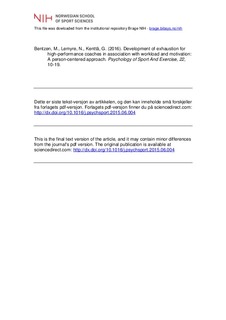| dc.contributor.author | Bentzen, Marte | |
| dc.contributor.author | Lemyre, Pierre-Nicolas | |
| dc.contributor.author | Kenttä, Göran | |
| dc.date.accessioned | 2018-01-31T08:54:15Z | |
| dc.date.available | 2018-01-31T08:54:15Z | |
| dc.date.issued | 2015-06-25 | |
| dc.identifier.citation | Psychology of Sport and Exercise. 2016, 22, 10-19 | nb_NO |
| dc.identifier.uri | http://hdl.handle.net/11250/2480845 | |
| dc.description | I Brage finner du siste tekst-versjon av artikkelen, og den kan inneholde ubetydelige forskjeller fra forlagets pdf-versjon. Forlagets pdf-versjon finner du på sciencedirect.com / In Brage you'll find the final text version of the article, and it may contain insignificant differences from the journal's pdf version. The definitive version is available at sciencedirect.com | nb_NO |
| dc.description.abstract | Objectives: The aim of the current study was twofold. First, to explore whether there were different trajectories of exhaustion among high-performance coaches over the course of a competitive season. Then, to investigate whether workload-related variables and motivational regulations were associated with exhaustion class membership. Methods and design: 299 high-performance coaches responded to an online survey at the start, middle, and end of a competitive season, assessing exhaustion, workload, work home interferencz (WHI), recovery, and motivational regulations. Latent class growth analyses were used to identify different trajectories of perceived exhaustion. Further, multinomial logistic regression examined class associations for workload-related variables and motivational regulations at the start and at the end of competitive season. Results: Four different trajectories of perceived exhaustion among coaches were identified, termed respectively “High” (10%), “Increase” (15%), “Decrease” (4%) and “Low” (71%). Higher levels of workload and WHI were associated to classes with higher levels of exhaustion. Higher levels of recovery, and intrinsic and identified regulations were associated to classes with lower levels of exhaustion. Adaptive and maladaptive profiles were identified. Conclusions: Different trajectories of exhaustion among high-performance coaches over the course of a competitive season were found. A maladaptive profile was associated with higher perceived workload and WHI, as well as lower levels of recovery, intrinsic and identified regulations, when compared to the adaptive profile. | nb_NO |
| dc.language.iso | eng | nb_NO |
| dc.publisher | Elsevier | nb_NO |
| dc.subject | exhaustion | nb_NO |
| dc.subject | person-centered approach | nb_NO |
| dc.subject | WHI | nb_NO |
| dc.subject | motivational regulation | nb_NO |
| dc.subject | high-performance coaches | nb_NO |
| dc.title | Development of exhaustion for high-performance coaches in association with workload and motivation: A person-centered approach | nb_NO |
| dc.type | Journal article | nb_NO |
| dc.type | Peer reviewed | nb_NO |
| dc.description.version | acceptedVersion | nb_NO |
| dc.rights.holder | © 2015 Elsevier Ltd. All rights reserved | nb_NO |
| dc.source.journal | Psychology of Sport and Exercise | nb_NO |
| dc.identifier.doi | 10.1016/j.psychsport.2015.06.004 | |
| dc.description.localcode | Seksjon for coaching og psykologi / Department of Coaching and Psychology | nb_NO |
